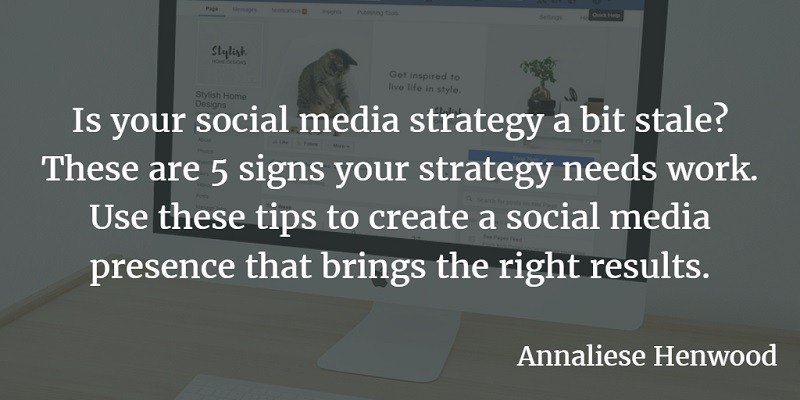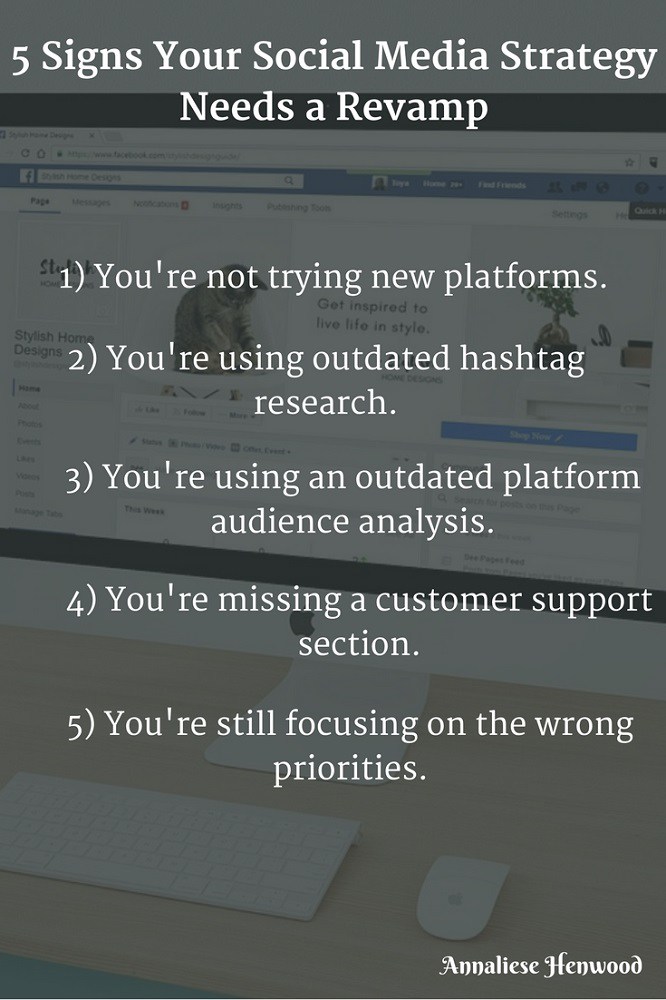Social media marketing needs you to be flexible because it always has new features and services. Just when you get used to Facebook, new tools like live video come along. New social platforms keep appearing, and your audience’s expectations for your brand are rising.
With all this change, have you applied what you need to within your social media strategy? Is your strategy flexible, or has it gotten outdated? These 5 areas of social media marketing require constant updates as your audience and social presence grows and expands.

— — —
1) Not trying new platforms
We are all familiar with Facebook, Twitter, LinkedIn, and other popular social media platforms. You may even use many or all of them. Your current social media strategy probably focuses on these well-known platforms, but your social presence is never finished. There will always be new platforms to explore.
Your target audience won’t stay in one place forever. They may be on Twitter now, but what will you do if they expand to Snapchat? Are you prepared to hop onto a whole new social platform? Does your social media strategy make room for that?
Yes, you should be open to trying new social platforms, and your strategy should allow for that. However, keep these important points in mind:
- Don’t join a new platform just because it’s new or popular. Your target audience and customers need to be actively present there. Otherwise, you’re wasting resources.
- Make sure you’re researching whether the platform fits with your business goals. If you’re looking for more lead generation, for example, Instagram isn’t as good a choice as other platforms, such as Twitter.
- Check the platform for whether you can have a worthwhile presence based on your business and industry. Do you have the resources to create live video? Consistent imagery? Are you able to publish 5+ high-value tweets every day?
Remember: your social media strategy should have the flexibility to add new worthwhile platforms or remove ones that are no longer effective. Social media is never static and will always be changing. Your business needs to be just as capable.
2) Outdated #hashtag research
Some social platforms use #hashtags to connect user content. Facebook, Twitter, Google+, and Instagram are the most common networks to use hashtags. Does your social media strategy include up-to-date hashtag research for these platforms (if you’re active on them)?
You risk having your social activity completely missed if you don’t use hashtags or if you use the wrong ones. The hashtags you’re currently using won’t always be the most effective over time. You need to constantly research them for a truly up-to-date social media strategy.
You have some options for how you can research the most effective hashtags for your business, audience, and content:
Those are three good resources to experiment with, but you can also take a different approach: using social monitoring.
With this, you choose targeted keywords related to your business, products, industry, etc. and follow all mentions on your active social platforms. For example, a B2B on Twitter can take advantage of monitoring tools to follow whether other users are mentioning their selected keywords, even if they aren’t actual hashtags.
Add any hashtag updates to your social media strategy as things change to keep your activity fresh and effective.
3) Outdated platform audience analysis
Everything you do on social media should be focused on reaching a specific audience. Your social media strategy should reflect that by including actual audience personas. When you create these personas, keep in mind that they are never set in stone.
Do you know who you’re targeting with your social media activity? That must be in your strategy, and it should always be up-to-date. You need to find your audience and know what they want, what their needs are. This requires researching the audiences on different social platforms and creating personas for each of them.
When you know the people you’re reaching out to via your social accounts, you see more results. When you keep your strategy’s personas current, you never lose touch with the people you want to see buy from you.
4) No customer support section
Your social media strategy is missing a huge, required element if it doesn’t have a customer support section. Businesses cannot ignore the need for social customer support anymore. Your strategy must include information for how you’ll handle complaints, issues, and even praise.
If people are complaining about you, ignoring them can make matters exponentially worse. If users are having issues with your product or service, you need to respond to them: thank them for telling you and reassure them that you’re working to fix the issue. If customers are praising you, this is a great opportunity to build that praise into brand loyalty – give your customers the power to be brand advocates.
In your social media strategy, write out when you’ll engage, how you’ll engage, and what you should do in case of a social crisis. Give your employees guidelines for handling customer support on social, but don’t restrict them to a script. Responses should always sound natural and be customized to the specific mention.
When you have a customer support section in your strategy, you give your social activity a boost because people are expecting it from you now.
5) Still focusing on the wrong priorities
Your social media marketing should always revolve around preset business goals. Most times, your main goal will be lead generation and ultimately, sales. Sometimes, your goal will include building your brand influence. Your social media strategy should reflect these goals.
Unfortunately, some businesses are still trying to use social media to force a sale. They’re not interested in engagement, relationship-building, or providing a quality experience. They use social media to heavily promote themselves with sales pitches and other nonstop promotions.
To make the most of social media, your business should find a balance that allows for reaching a sale while also providing a service to your audience. Give them useful information, such as from your blog, to help them solve a problem they’re having. To bring in leads, offer an eBook or webinar that requires a form submission. Use social media advertise to further emphasize its value and reach, but keep it relevant to the audience you’re targeting.
Your social media strategy should make room for multiple priorities, but it should not focus on the end sale. Social media is about being engaging and building a community first. Lead generation comes from using social media as a social platform, not a press pedestal.
— — —
What are you going to do with your social media strategy now?
You now know 5 of the most important elements to work on, so it’s time to get moving. As a recap, these are 5 of the most important points to remember:
- Always be open to trying new social platforms, but keep your focus on the platforms your target audience is active on, not any others.
- Use hashtag research to keep your strategy updated with the techniques that’ll get your activity seen by the right audience at the right time.
- Create and maintain personas to keep your activity targeted toward the right audience per platform.
- Your business cannot afford to neglect social media customer support, so include a section in your strategy that covers this important element of your activity.
- Social media doesn’t offer an instant ROI, so your priority should be on providing value first, which will eventually bring in leads over time.
Do you have any questions? What tips do you have for keeping a social media strategy fresh and effective? Leave a comment with your input!
